

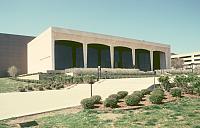
|
This museum is named for Amon G. Carter, Sr. (1879-1955) whose collection of works by Frederic Remington and Charles M. Russell is housed in the museum and whose foundation purchased part of the land on which the museum stands. Although this is still an early work by Philip Johnson, who with Mies was one of the originators of the "international style," it is less unadorned than "pure" works in that style. Still it uses repetition--a five-bay portico with flat arches--and a tinted glass curtain wall, here with elegant bronze mullions. Creamy native Texas shellstone is used for the exterior and parts of the interior. | |
| Johnson created a processional entrance with granite steps in a series of landings and platforms. This entryway leads to the great portico, or loggia, in the style of many Classical and Renaissance Italian buildings. | 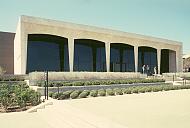
|
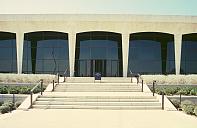
|
| The two-story portico is supported by tapered limestone pillars, concave on 4 surfaces, which terminate in small bases in a cross-shape. Initially, these tapered columns were controversial, described as "ballet-classicism." The main entrance leads into a two-story lobby and exhibit hall of Texas shellstone, expensive brown teak, and a pink granite floor. | ||

|
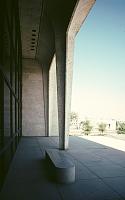
|

|
| The museum is sited on so-called "museum hill" looking toward the downtown skyline. This position provides a way of uniting visually the museum and the city. Ths museum is now part of the "museum district" with the Kimbell Art Museum by Louis Kahn and the Modern Art Museum of Fort Worth by Tadao Ando nearby. | ||

| 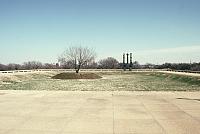
|
The sunken garden on the east is aligned with the museum to city axis as are the three sculptures by Henry Moore on a single base, designed by Johnson. For additional views, see Moore's Upright Motives. |
 Click here to return to index of art historical sites.
Click here to return to index of art historical sites.
 Click here to return to index of artists and architects.
Click here to return to index of artists and architects.
 Click here to return to chronological index.
Click here to return to chronological index.
 Click here to see the home page of Bluffton College.
Click here to see the home page of Bluffton College.
